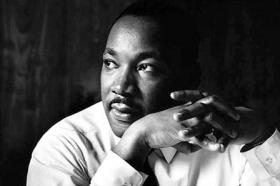On a Saturday night in mid-December, guitarist Adam Rogers called pianist Vijay Iyer to the stage of the Jazz Gallery, on Hudson Street. As the pianist made his way, Mr. Rogers recalled spots such as Studio RivBea and Soundscape, the loft spaces and clubs that, decades ago, helped nurture adventurous jazz and its audience in Manhattan. "Of all the venues in New York City," he told the audience, "the Jazz Gallery is the one that carries on that same vibe and purpose."
There was cause for reflection. This was the final performance in this second-story spot. The building had been rezoned, soon to house residential lofts. Paintings by Alix Delinois that lined the walls—it was an actual gallery, too, of jazz-related art—would be packed up, along with memorabilia from 17 years of activity.
Natalie Keyssar for The Wall Street Journal
Rio Sakairi, left, and Deborah Steinglass unwrap a poster in the Jazz Gallery's new space on Broadway, in the Flatiron District.
Deconstructing the ballad "I Fall in Love Too Easily," Mr. Iyer marked the midpoint of a night featuring nearly two-dozen musicians with close ties to the venue. Some, like him, found early exposure here before achieving broader success. It's also true of pianist Jason Moran, saxophonist Miguel Zenón and drummer Dafnis Prieto, all three now MacArthur Foundation Fellows. Nine of the past 11 winners of the Thelonious Monk International Jazz Competition played the gallery prior to their victories.
As Mr. Iyer said later, "In the 14 years I've lived in New York, I can't imagine how my life would have unfolded without the Jazz Gallery. Improvisation is how we develop, change and become something new. The spontaneous musical offering on this last night was a kind of community ritual, expressing that simple truth."
The Jazz Gallery's staff had to improvise last year, not to help it become something new but to transplant its essence. Less than a week after that jam session, Deborah Steinglass, the gallery's executive director, announced a new home for the nonprofit organization.
On Thursday, saxophonist Darius Jones and his quartet will inaugurate the new space, at 1160 Broadway, just north of the Flatiron Building. Mr. Jones—a soulful, adventurous musician—and other scheduled performers extend the gallery's signature of forward-leaning music that often crosses geographic borders: Argentine bassist Pedro Giraudo will lead his big band on Friday and Saturday; the dynamic bassist Linda Oh plays Jan. 25; saxophonists Roman Filiu, from Cuba, and Melissa Aldana, from Chile, perform later this month.
One recent afternoon, sunlight streamed through the new gallery's skylight. "It's cozy, right?" Ms. Steinglass said. "Sort of looks and feels like the old spot." Beside her, Rio Sakairi, the director of programming for the past 13 years, described her aesthetic as simply "soulful" music.
"That's not a stylistic reference," Ms. Sakairi said. She's most interested in individualized statements from musicians. "I want the music to tell us who you are," she said.
Such artistic commitment often requires support beyond a simple gig. The gallery's longstanding commission and residency programs helped composer Darcy James Argue develop music that earned his Secret Society big band a Grammy nomination. For seven years, saxophonist Steve Coleman has led Monday-night improvisation workshops. Last year, the Woodshed, funded through an online Kickstarter campaign, made the gallery available during off hours as a rehearsal space.
The need to move, plus the challenges now common to all arts organizations, set off an ambitious development drive. The gallery has raised roughly one-quarter of the $250,000 target for its current "Home Run" campaign, and its long-term future is far from clear. It will share the new fifth-floor space with the Gallery Church (the similar names are coincidental). That agreement runs through February 2014, with hopes for a much longer stay, according to Ms. Steinglass.
Dale Fitzgerald, the Gallery's executive director until 2009, leased the original spot in 1995 as a rehearsal space for trumpeter Roy Hargrove. The two ended up founding a nonprofit venue. "My idea from the start was that jazz is an international and interdisciplinary language," Mr. Fitzgerald said. Michael Cummings's jazz-themed quilt hung near the front door. One photo exhibition displayed images of Havana as seen by Cuban and American photographers. The Gallery has especially showcased and nurtured New York's vital Afro-Latin presence. For saxophonist Yosvany Terry and Mr. Prieto, its "Jazz Cubano" series extended collaborative experiments the two began while students in Havana. "It was our new laboratory," Mr. Terry said, "in our new city."
At the new Jazz Gallery, a volunteer arranged chairs, leaving the customary narrow aisle for performers toward the stage. Ms. Steinglass said, "I want this to remain informal, without much separation between artist and audience."
Mr. Fitzgerald likes that the new spot hosts church services on Sundays. "I always did feel," he said, "like this place was built on faith."
A version of this article appeared January 16, 2013, on page A25 in the U.S. edition of The Wall Street Journal, with the headline: New Lease for Jazz Gallery.








 VENDREDI 1ER FEVRIER 20:00
VENDREDI 1ER FEVRIER 20:00
 IN EXTENSO A LA PROGRAMMATION ARTISTIQUE, L'ASSOCIATION TRIG - pour la promotion des arts sonores et numériques - PROPOSE DES SOIREES MUSICALES INSOLITES ET DE HAUT VOL AU P
IN EXTENSO A LA PROGRAMMATION ARTISTIQUE, L'ASSOCIATION TRIG - pour la promotion des arts sonores et numériques - PROPOSE DES SOIREES MUSICALES INSOLITES ET DE HAUT VOL AU P


